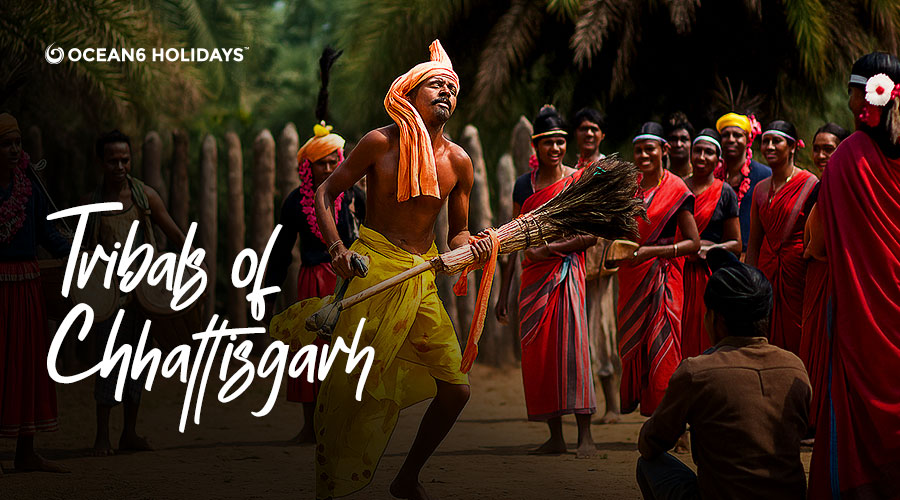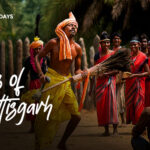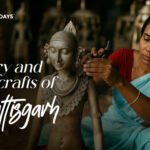A Journey into the Heart of India’s Living Heritage
Introduction: Chhattisgarh – Land of Tribal Wonders
Nestled in the heart of India, Chhattisgarh is a state blessed with rich cultural heritage, dense forests, rolling hills, gushing waterfalls, and a vibrant tribal legacy that stretches back thousands of years. Known as one of India’s most culturally diverse regions, Chhattisgarh is home to more than 40 tribal communities, each with its own unique language, customs, attire, festivals, and ways of life.
From the rhythmic beats of traditional drums echoing in forest hamlets to the vivid colours of tribal attire during festivals, Chhattisgarh’s tribal culture is not just history – it’s a living, breathing celebration of harmony between humans and nature. For travellers seeking authenticity, tribal tourism here offers a rare glimpse into age-old traditions that have remained untouched by modernity.
The Cultural Tapestry of Chhattisgarh’s Tribes
Tribal life in Chhattisgarh is deeply rooted in the cycles of nature. Forests are not just resources – they are sacred spaces that sustain life and provide everything from food and medicine to spiritual inspiration. Most tribes live in close-knit communities, speaking their own dialects, often from Dravidian or Austroasiatic origins, and practicing age-old customs of self-reliance, barter trade, and community festivities.
Festivals are at the heart of tribal life, often linked to agricultural cycles and seasonal changes. Ceremonies, dances, and music are not mere entertainment – they are spiritual expressions of gratitude to deities, ancestors, and nature.
Major Tribes of Chhattisgarh
1. The Gond Tribe
The Gonds, also known as Koytorias, are among the largest and most prominent tribes in Chhattisgarh, particularly concentrated in the Bastar region. They inhabit dense forests that account for over 20% of the state’s population. The Gonds are divided into several sub-castes, including the Dorla, Maria, and Muria tribes.
Culture & Lifestyle
The Gonds have a vibrant and colourful way of life. They are known for their exquisite bead and metal jewellery, intricate tattoo art, and traditional weaving. Marriages are usually within the community, and festivities like Navakhana, Mati Puja, and Goncha are celebrated with grandeur.
Tourist Experience
Visitors can witness Gond folk dances, traditional drumming performances, and explore weekly haats (markets) where handmade crafts, forest produce, and jewellery are sold.
Tourist can stay and experience at Karma Ethnic Resort, Baiga Ethnic Chilpi , Dhankul Ethnic Resort, Sarna Ethnic Resort.
2. Abhuj Maria Tribe
A sub-caste of the Gond tribe, the Abhuj Marias inhabit the secluded forest areas of Narayanpur in Bastar district. Their homeland is a dense forest covering nearly 1,500 square miles, rich in biodiversity.
Culture & Traditions
The Abhuj Marias are known for their reserved nature, often keeping to themselves and practicing centuries-old methods of farming, hunting, and gathering. They still follow their traditional livelihood practices and hold sacred beliefs tied to nature.
Tourist Experience
Their isolation makes them rare to encounter, but festivals and special cultural events in Bastar sometimes feature Abhuj Maria dances, giving visitors a glimpse into their traditions.
Tourist can stay and experience at Dandami Luxury Resort, STF Camp Resort.
3. Bison Horn Maria Tribe
One of the most visually striking tribes, the Bison Horn Marias are named after their unique headgear that resembles the horns of a bison. This elaborate headdress is worn during dances and ceremonies, paired with bright red and yellow attire.
Language & Culture
They primarily speak the Dandami Maria dialect, though some also speak Gondi. Music, dance, and ceremonial rituals are central to their identity.
Tourist Experience
For travellers, witnessing a Bison Horn Maria dance is unforgettable – the synchronized drum beats, colorful costumes, and horned headdresses create a powerful spectacle.
Tourist can stay and experience at Dandami luxury Resort, STF Camp Resort.
4. Muria Tribe
The Murias, another prominent Gond sub-caste, reside mainly in Narayanpur and Kondagaon districts. They are skilled in agriculture and forest produce collection.
Cultural Highlights
The Murias are famous for their community dances and love for jewellery. Women wear beautiful bead necklaces and metal ornaments, while men participate in vibrant festivals with traditional music.
Tourist Experience
Muria dances during harvest festivals are a visual treat for visitors, often involving elaborate group formations and rhythmic drumming.
Tourist can stay and experience at Dandami Luxury Resort, STF Camp Resort.
5. Halba Tribe
Spread across Durg, Bastar, and Raipur districts, the Halba tribe has three sub-clans: Chhattisgarhia, Bastaria, and Maratia.
Lifestyle & Culture
They are primarily agriculturalists but also engage in weaving and handicrafts. Their festivals are colourful and community-oriented, with traditional songs and dances forming an integral part.
Tourist Experience
Travelers can explore Halba villages to see their weaving techniques, taste traditional foods, and participate in festive gatherings.
Tourist can stay and experience at Dandami Luxury Resort, STF Camp Resort, Saila Tourist Resort.
6. Korva Tribe
Found in Bilaspur, Sarguja, and Raigarh districts, the Korvas are divided into Pahari Korva (hill dwellers) and Dihariya Korva (plains dwellers).
Unique Traits
They are skilled hunters and farmers, often seen carrying bows and arrows. Both men and women wear abundant ornaments and colourful attire.
Tourist Experience
Visitors can engage in guided village tours to learn about their bow-making, agriculture, and forest-based crafts.
Tourist can stay and experience at Hareli Eco Resort.
7. Kamar Tribe
Located in the Raipur and Bastar regions, the Kamars are traditionally hunters.
Beliefs & Traditions
They worship iron and forest deities, as well as Mother Earth, offering drops of liquor before consumption as a sign of respect.
Tourist Experience
Kamar cultural events often feature storytelling, folk music, and rituals that reflect their deep bond with the land.
Tourist can stay and experience at Hareli Eco Resort.
8. Baiga Tribe
Predominantly found in Kawardha and parts of Bastar, the Baigas are among India’s most primitive tribal groups.
Distinctive Aspects
Interestingly, Baiga women outnumber men, and marriage practices often involve endogamy. They are expert farmers, hunters, and craftsmen.
Tourist Experience
Tourists can visit Baiga markets, watch traditional dance performances, and explore their herbal medicine knowledge.
Tourist can stay and experience at Baiga Ethnic Chilpi.
9. Dhurvaa Tribe
Inhabiting the Bastar region, the Dhurvaas are primarily agriculturists and skilled forest product craftsmen.
Tourist Experience
They are known for their artistic bamboo work and forest produce markets, which attract visitors interested in authentic tribal crafts.
Tourist can stay and experience at Hareli Eco Resort.
10. Bhatra Tribe
Found in Bastar and Raipur, the Bhatras are renowned for their skill in agriculture and craftsmanship.
Tourist Experience
Cultural programs featuring Bhatra dances and music are a highlight for visitors seeking an immersive experience.
Tourist can stay and experience at Dandami Luxury Resort.
Sacred Beliefs and Festivals
Chhattisgarh’s tribes worship nature in its many forms – from the Mahua tree to the Anga Dev deity carved from sacred wood. Festivals like Kaksar, performed before the monsoon, serve as both religious ceremonies and social gatherings where young men and women choose life partners.
Why Visit Tribal Chhattisgarh?
- Authentic Cultural Immersion – Witness traditions unchanged for centuries.
- Unique Art & Craft – Beadwork, bamboo crafts, metal forging, and textiles.
- Nature & Adventure – Explore untouched forests, hills, and waterfalls.
- Festivals & Music – Experience the joy of community celebrations.
Conclusion: Preserving a Living Heritage
The tribes of Chhattisgarh are not just communities – they are guardians of an ancient way of life, living in harmony with nature and preserving customs that the modern world often forgets. Visiting these tribes is more than tourism; it’s an opportunity to connect with India’s roots, to understand resilience, and to appreciate cultural diversity.
For travellers, Chhattisgarh offers not just a destination, but an experience – one that stays in your heart long after you’ve left.






